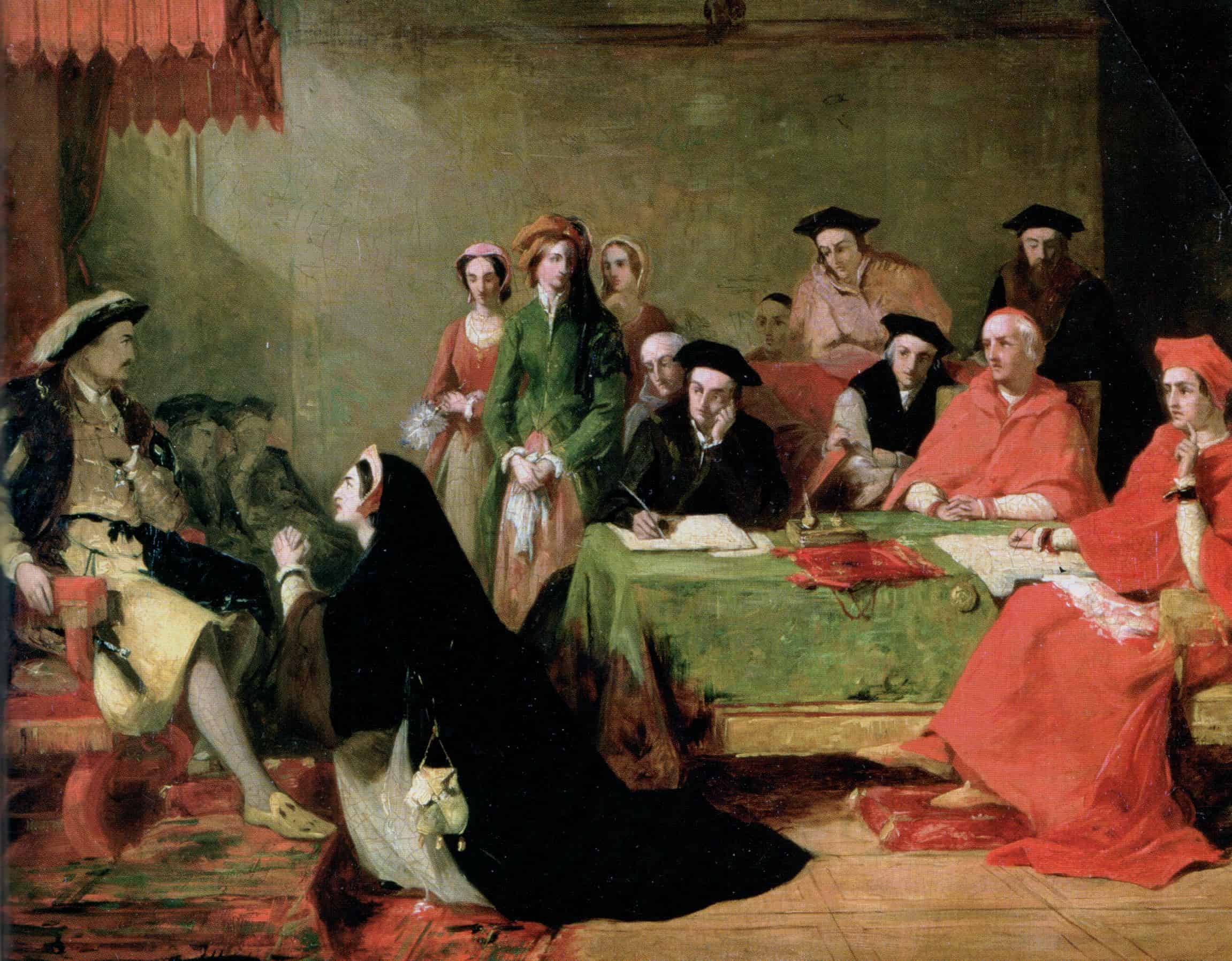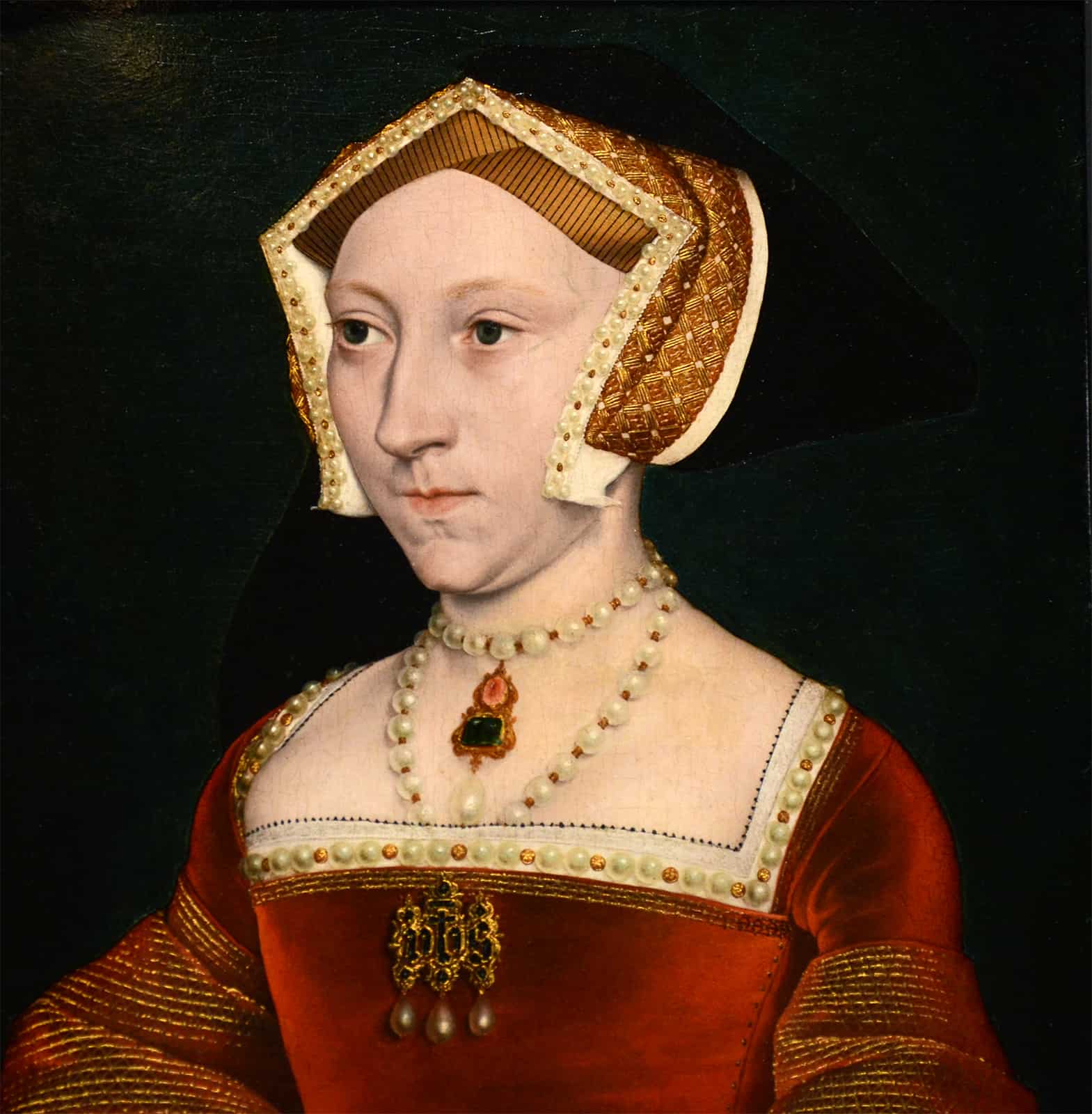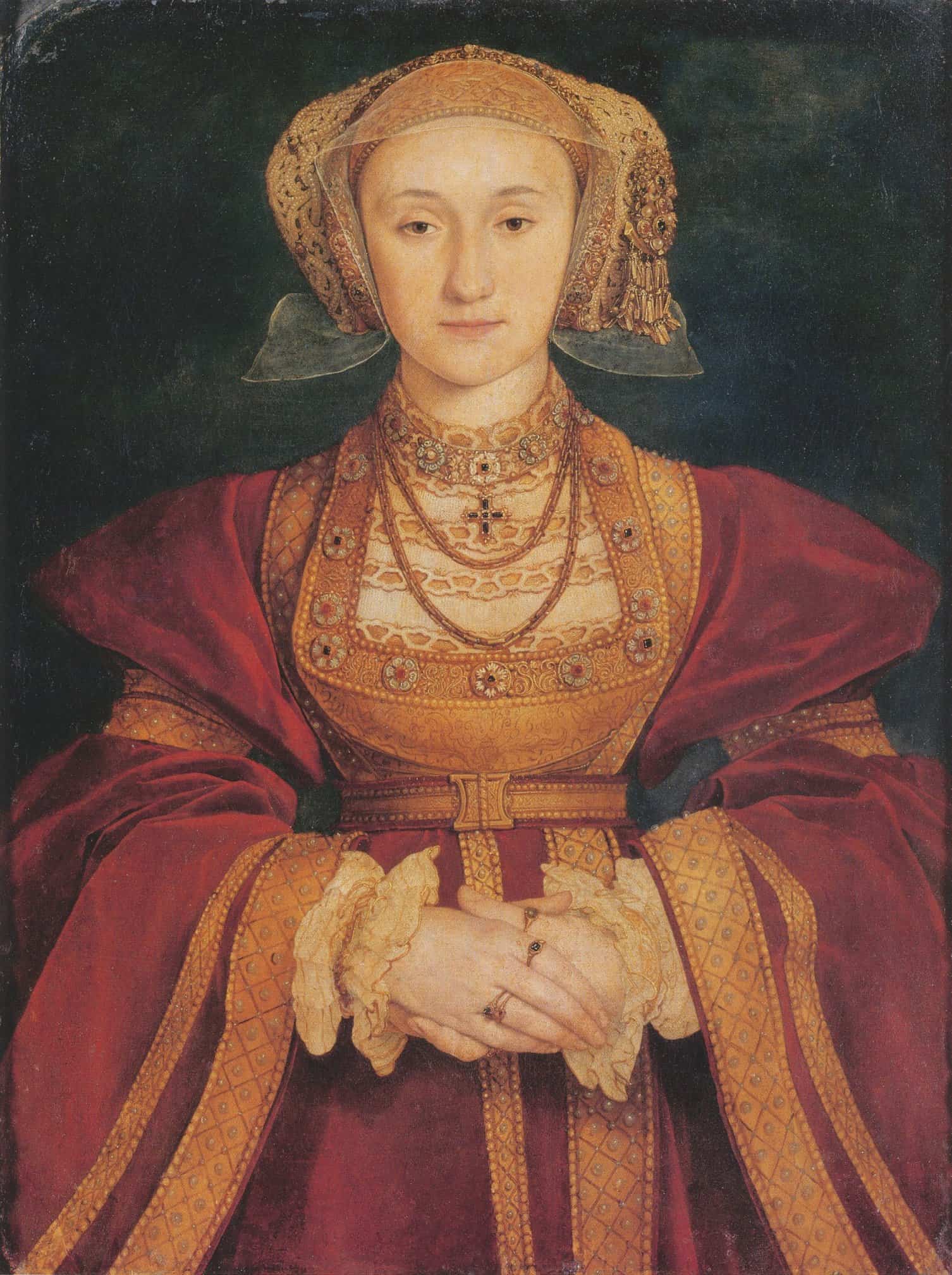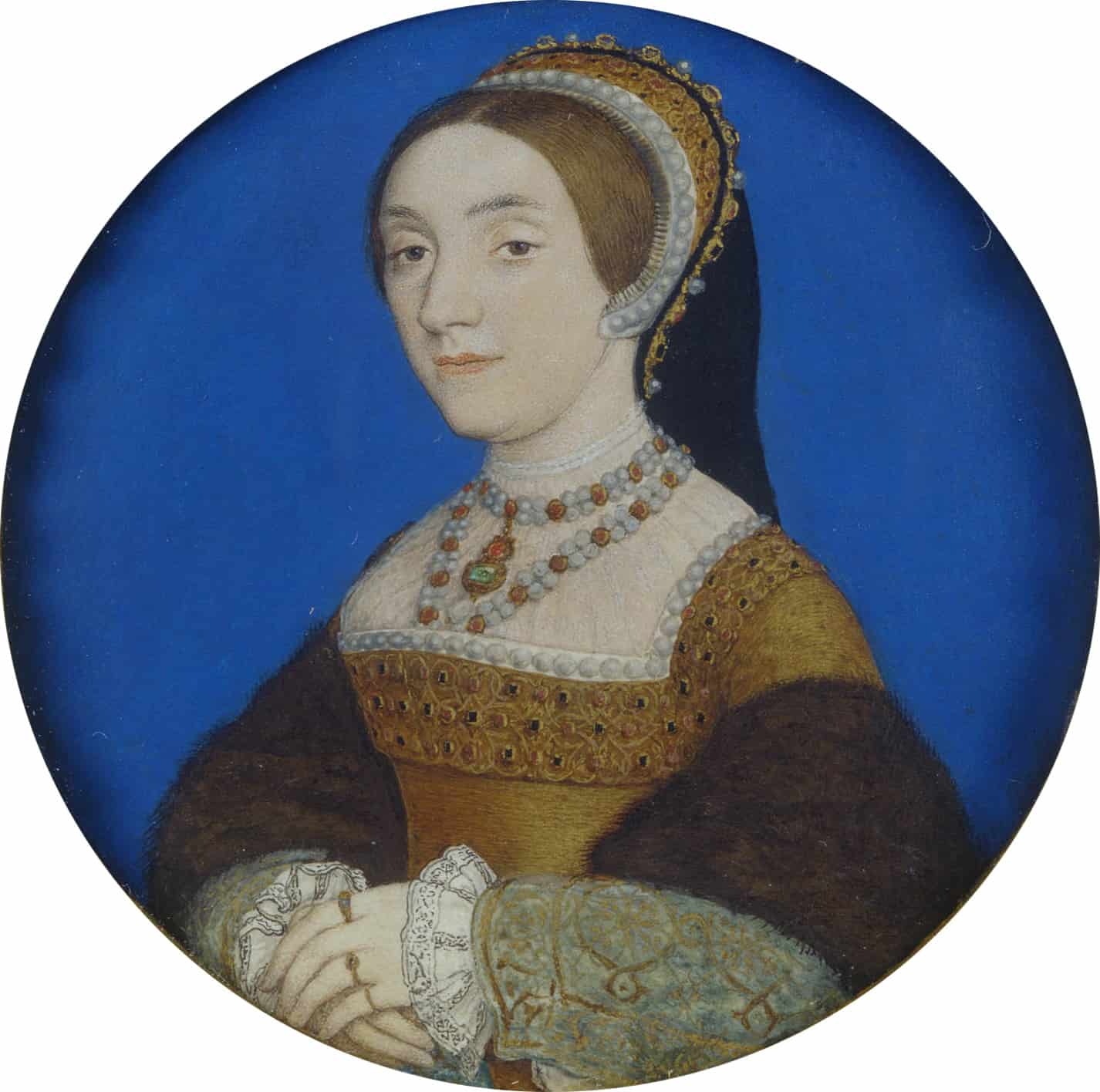Key Facts & Summary
- ‘Divorced, beheaded, died; divorced, beheaded, survived’: this saying sums up the relationship Henry VIII had with his wives.
- Henry VIII’s wives were: Catherine of Aragon, Anne Boleyn, Jane Seymour, Anne of Cleves, Catherine Howard, and Catherine Parr.
Catherine of Aragon
Soon after his accession, in June 1509, Henry married his brother’s widow, Catherine of Aragon. Their marriage was carried out in order to strengthen the relation between England and Spain. In fact, Catherine was the daughter of Isabella I of Castile and Ferdinand of Aragon, and was born on December 16, 1485. During her childhood, the young Catherine travelled much around Spain since her parents were fighting against the Muslims in Granada (Lewis 2017). As a consequence, she was not able to officially engage her time studying and educating herself. Nonetheless, she was mentored by ‘European humanists’ (Lewis 2017). The young girl was able to speak in several languages including Latin, Spanish, English, and French; and was also instructed in theology and philosophy.
In 1498, a marriage was arranged between Catherine and the Prince Arthur, and their union was officialise in November 1501. However, their marriage was never consumed, and therefore, she was able to marry his brother Henry VIII, in 1509. Queen Catherine gave birth to six children, yet, only one of them survived: Mary I of England. Henry VIII was desperate for a male heir, and not having obtained one by Catherine, he sought to annul their marriage.
The marriage’s annulment was not easy to obtain: in fact Cardinal Thomas Wolsey attempted to gain the pope’s permission for divorce. However, Catherine did not want to divorce her husband and thanks to the ‘speech of her life’, the pope did not give such concession. As a consequence, Thomas Cromwell took the lead and suggested the king to break with the Church of Rome and become in control of the Church of England through the Act of Supremacy (1534). Thanks to Cromwell’s intervention, Henry VIII managed to divorce from Catherine of Aragon. They had been married for over twenty years.
Anne Boleyn
Born in 1501, Anne Boleyn is the indirect cause of the Reformation in England. She was the daughter of Thomas Boleyn, the Earl of Wiltshire. She carried out her education in the Netherlands and in France, were she became main of honour of Francis I’s wife.
Although Anne was engaged to the 5th Earl of Northumberland, Cardinal Wolsey refused to marry them, and Anne was obliged to make her way back to her home in Hever Castle. In 1526, Henry VIII was struck by Anne’s ‘beauty and charm’ (Pettinger 2017). The king tried to seduce the young girl numerous times, but she refused his ‘advances’ since she did not want to become a mistress. Anne claimed she would succumb to his love only if Henry ended his marriage with Catherine of Aragon.
The future queen of England supported the reform movement as well as William Tyndale’s translation of the Bible (it is necessary to remember, however, that Henry VIII was Catholic and strongly averse to Protestantism).
In 1528, Anne contracted the sweating disease and almost died. On January 25, 1533, Henry VIII and Anne married, and she was crowned queen of England six months later.
In September of the same year, the queen gave birth to Elizabeth I, and all her following pregnancies were miscarriages. The love affair between the two ‘quickly soured’ not only because Anne was not able to birth a male heir, but also because she disagreed with the religious reforms that the king was enacting (Pettinger 2017).
In April 1536, Anne Boleyn was arrested for high treason: she was charged with the accuse of ‘adultery, incest, and plotting to kill the king’ (Pettinger 2017). Although Anne had not committed any of the accusations above, she was executed and her last words were ‘Jesus receive my soul; O Lord God have pity on my soul’ (Pettinger 2017).
Jane Seymour
Jane Seymour was born sometime between 1504-1509. She was Catherine of Aragon’s lady-in-waiting and also witnessed the relationship between the king and Anne Boleyn.
Jane ‘was known for her quiet and sooting manner’ (English History), and, although the king knew who she was, he became enamoured with her in 1536 and Henry provided her with expensive gifts. On May 30, 1536, the two married, and Jane was immediately able to give birth to the king’s greatest wish: a male heir, Edward.
The birth of Henry’s son was greatly celebrated all throughout England. However, Jane did not live long, and ‘the christening ceremony had begun in her bed chamber’ (English History). Before dying, the queen suffered from weakness, exhaustion, high fever, and delirium. According to some historians, Jane died because of puerperal sepsis, i.e. childbed fever. At her death, Jane received a solemn funeral and her body was embalmed.
Anne of Cleves
Following Jane Seymour’s premature death, the king wore black until 1538, and did not marry for two years. One of the reasons he did not marry consisted in the fact that the king had gained a bad reputation amongst European women. Therefore, Henry assigned a mission to his closest advisors: that of travelling Europe with the intention of finding him a new consort. Thomas Cromwell suggested Anne of Cleves as a possible candidate: she was German and fully supported Protestantism. According to Cromwell, such union would reinforce the reformation in England. Therefore, on the January 6, 1540, the two officially married: however, Henry declared that he was not able to consume the marriage since he did not find her attractive. He was repulsed by her, and could not get around fulfilling his marital duties: in fact, when Cromwell asked the king ‘how liked you the Queen?’, he replied ‘I liked her before not well, but now I like her much worse’. Protestants, Henry VIII executed Cromwell on July 28, 1540. Henry VIII divorced from her only four months after their marriage. However the two remained on good terms.
In fact, after the two consorts divorced, Henry VIII was incredibly grateful for Anne’s collaboration, and decided to reward her by offering her manors, estates, and an income of three-thousand pounds per year. The king also defined her as a ‘good sister’ and guaranteed her ‘precedence over all ladies in England, except the Queen and [his] daughters’ (Hanson 2015). Furthermore, thanks to the financial stability that her divorce had brought her, Anne spent much of her money on gambling and beautiful gowns. She was also allowed to visit the king, spend time with his children and was always welcomed to his banquets.
Katherine Howard
Katherine is perhaps one of the most controversial wives of Henry VIII. In fact, she is known to having had numerous love affairs. on July 28, 1540. On the same day of Thomas Cromwell’s execution, Henry VIII married Katherine Howard, a beautiful and very young woman: she was gifted expensive jewellery by her new husband, and she officially became queen on August 8.
However, little did Henry know about her past: in fact, when she lived in her grandmother’s residence at Tilney, she entertained a love affair with her music teacher, Henry Manox; and subsequently with Francis Dereham. Moreover, she entertained an amorous liaison with one of her husband’s favourites, Thomas Culpeper, and brought to court her former lovers Manox and Dereham. On November 2, 1541, Katherine’s reckless behaviour was denounced by Archbishop Cranmer to Henry VIII. Howard was not forgiven by the king, and heavy charges were imposed upon her: in fact, she was accused of (I) ’unchastity’ before her marriage; (II) the ‘concealing’ of sexual relations before her marriage (considered treason); (III) and engaging in adulterous behaviours (also considered treason) (Lewis 2019). As a consequence, Howard lost her title of queen on November 23, 1541. Culpeper and Dereham did not have a happy ending, and on December 10 of the same year, they were executed: their heads were exposed on London Bridge.
On January 21, 1542, Katherine Howard was condemned to death with the charge of treason. Therefore, on February 10, she was brought to the Tower of London, and three days later, she was beheaded and buried in the chapel of St. Peter ad Vincula.
Catherine Parr
Born in 1512, Catherine was the daughter of Sir Thomas Parr (who was a descendant of Edward III), and Maud Green, one of Catherine of Aragon’s lady-in-waiting. She was passionate about learning and had strong knowledge of French, Italian, and Latin.
Throughout her life, Catherine married four times. Nonetheless, on July 12, 1543, she became Henry VIII’s final wife: the two held a ‘small ceremony at Hampton Court Palace’ (Ridgway no date). Thanks to her influence, Henry VIII ‘passed an act’ that gave his daughters the right of succession to the throne of England.
However, because of this act, Catherine was arrested since the reformists managed to turn the king against his wife. Nonetheless, ‘the quick-thinking Catherine Parr managed to save her head by pleading with Henry and persuading him that she had only argued with him in an attempt to help him forget about the pain caused by his leg ulcer’ (Ridgway no date). In 1547, the king died, and Catherine Parr married her former lover Thomas Seymour.
Bibliography
[1.] Frable, B. (1998). Catherine of Aragon. Queen of England. [online] Available from: http://departments.kings.edu/womens_history/cathyaragon.html
[2.] Lewis, J.J. (2019). Biography of Katerhine Howard of England. ThoughtCo.
[3.] Lewis, J.J. (2017). Catherine of Aragon – Early Life and First Marriage. [online] Available from: https://www.thoughtco.com/catherine-of-aragon-early-life-3528150
[4.] Pettinger, T. (2017). Biography of Anne Boleyn. [online] Available from: https://www.biographyonline.net/women/anne-boleyn-biography.html
[5.] Ridgway, C. (no date) Catherine Parr. The Anne Boleyn Files.
Image sources:
[1.] https://upload.wikimedia.org/wikipedia/commons/f/fd/6zon.jpg
[2.] https://farm4.staticflickr.com/3837/14567056623_5e4ae42a60_b.jpg
[8.] https://upload.wikimedia.org/wikipedia/commons/8/81/Catherine_Parr%2C_attributed_to_Master_John.jpg







